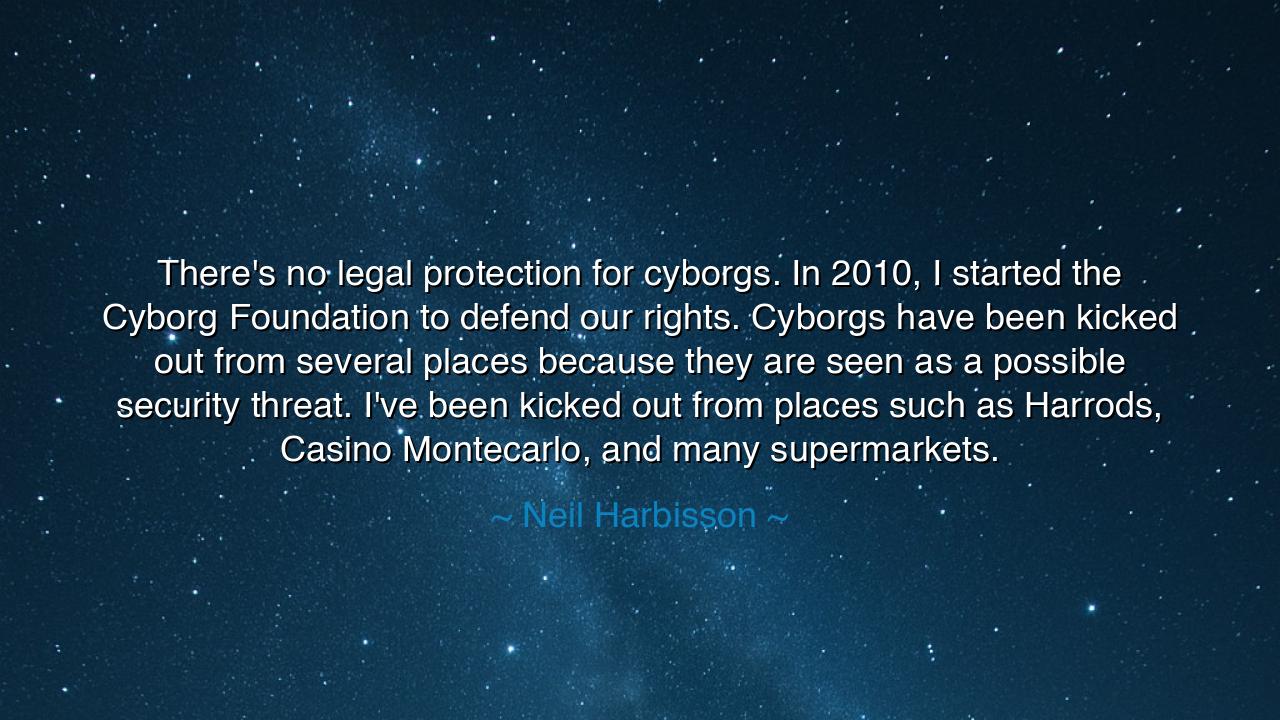
There's no legal protection for cyborgs. In 2010, I started the
There's no legal protection for cyborgs. In 2010, I started the Cyborg Foundation to defend our rights. Cyborgs have been kicked out from several places because they are seen as a possible security threat. I've been kicked out from places such as Harrods, Casino Montecarlo, and many supermarkets.






Hear the words of Neil Harbisson, the first man to be recognized as a cyborg, who declared: “There’s no legal protection for cyborgs. In 2010, I started the Cyborg Foundation to defend our rights. Cyborgs have been kicked out from several places because they are seen as a possible security threat. I’ve been kicked out from places such as Harrods, Casino Montecarlo, and many supermarkets.” In this cry, we hear the voice of one who walks between two worlds—the world of flesh and the world of machine—and who demands that dignity follow him into this new frontier.
The origin of this saying lies in Harbisson’s own life. Born colorblind, he implanted an antenna into his skull that allows him to perceive colors as sound vibrations. Through this union of biology and technology, he became a cyborg, not as science fiction but as living truth. Yet in his journey, he discovered that society’s laws had not yet followed him into this new existence. Where human rights end, and machine rights begin, no statute yet speaks. Thus, he founded the Cyborg Foundation—not for himself alone, but for all who will one day join flesh to circuit and claim this identity.
History reminds us that the birth of every new identity has been met with suspicion and rejection. When Christians first proclaimed their faith in Rome, they were seen as a threat to the empire and cast out of markets, theaters, and courts. When Jews in medieval Europe held to their ways, they too were expelled from cities, deemed dangerous to the order of the realm. Even in our modern age, those who bore new cultures, new colors, or new beliefs have been met with walls, laws, and exile. Harbisson’s story is but the newest chapter in this long saga: the fear of the unfamiliar turned into persecution.
His words reveal the paradox of progress. The same society that praises innovation may punish the innovator; the same world that delights in machines may exile the man who becomes one. Harbisson’s exile from places like Harrods or Casino Montecarlo is not truly about security, but about discomfort with what is not yet understood. To see a man with an antenna is to be reminded that humanity itself is changing—and many fear such change. Yet history shows that what is feared today may be embraced tomorrow, when wisdom catches up with invention.
The meaning of this teaching is profound: as technology fuses with our bodies, the question of rights must also evolve. If a prosthetic leg is protected as part of a human body, then why not an implanted antenna? If speech is protected, why not digital perception? Harbisson’s fight is not only for cyborgs, but for the principle that dignity should extend wherever humanity extends, even into the realm of the mechanical. To deny this is to abandon our brothers and sisters at the threshold of a new era.
The lesson, O listener, is that society must learn to embrace the frontier of identity with courage, not fear. Just as past generations fought for civil rights, for women’s rights, for the rights of the disabled, so too will future generations fight for the rights of the cyborg. And each of us must be ready—not to mock, not to exile, but to ask: what does it mean to be human? And how do we protect that humanity when it expands beyond flesh alone?
And what shall we do in our own lives? We must begin by practicing compassion toward the unfamiliar. When confronted with the strange, seek to understand rather than to expel. Support laws and movements that expand protections to new forms of identity, for in so doing, we secure the dignity of us all. Teach our children that technology is not an enemy but a tool, and that those who wield it to heal or to enhance are still our kin.
So remember the teaching of Neil Harbisson: there is as yet no legal protection for those who walk the path of the cyborg, but there must be. For the future will bring many such beings, and when it does, our test will be whether we greet them with chains of suspicion or with the open hand of justice. Embrace this truth, and you will help build a world where humanity, in all its forms, may live with dignity.






AAdministratorAdministrator
Welcome, honored guests. Please leave a comment, we will respond soon